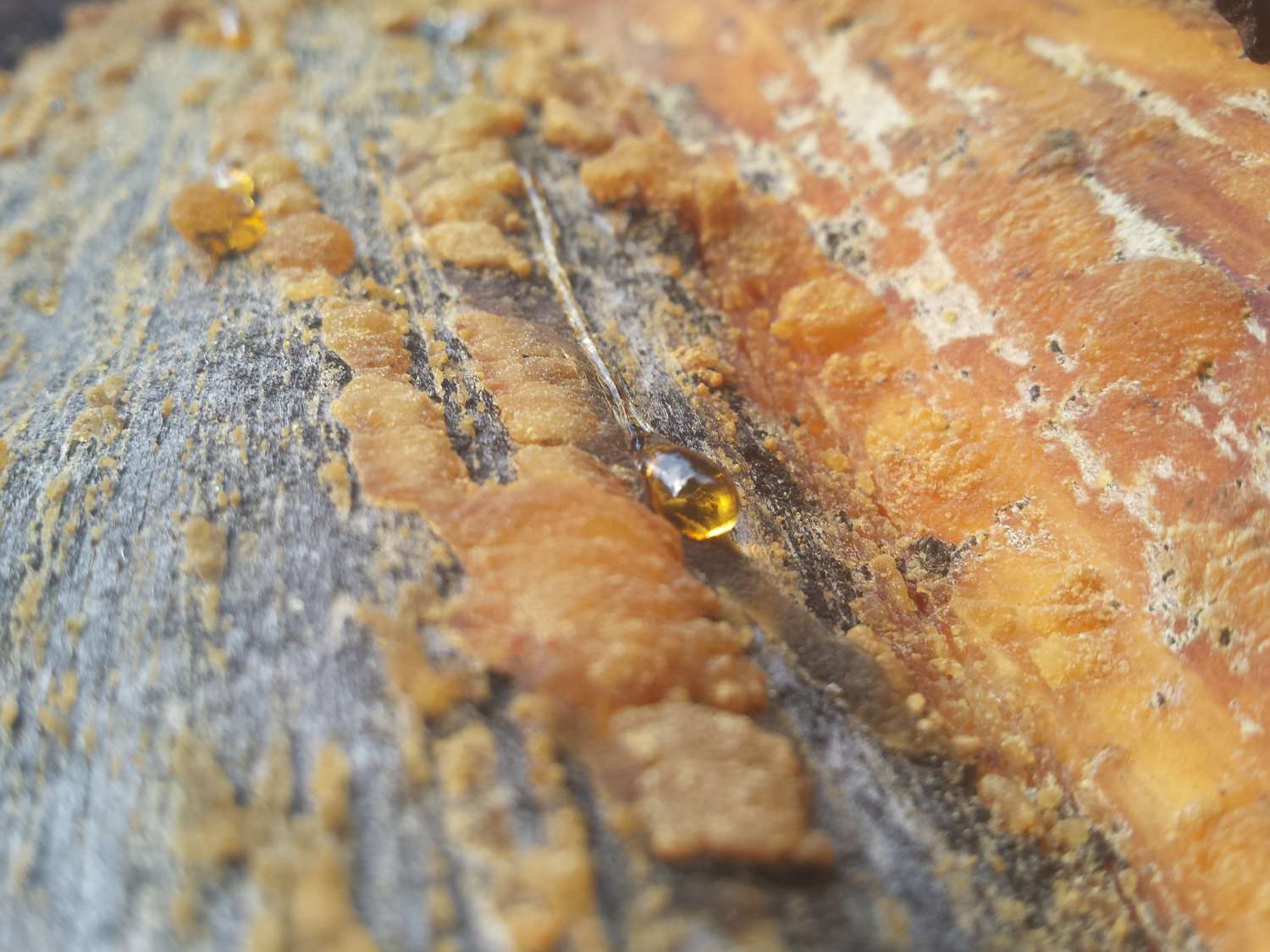Home>Gardening News and Trends>Latest News>Why Do Trees Have Sap


Latest News
Why Do Trees Have Sap
Published: November 6, 2023
Discover the Latest News on Why Trees Have Sap. Explore the fascinating reasons behind this natural phenomenon and its importance in tree growth and protection.
(Many of the links in this article redirect to a specific reviewed product. Your purchase of these products through affiliate links helps to generate commission for Chicagolandgardening.com, at no extra cost. Learn more)
Table of Contents
Introduction
Trees are an integral part of our natural environment, providing us with an array of benefits such as shade, oxygen, and habitat for wildlife. When we think about trees, we often envision their towering trunks, lush foliage, and sturdy branches. However, there is one element that is essential to the survival and health of trees, yet often goes unnoticed – sap.
Sap plays a crucial role in the life of trees, carrying out vital functions that contribute to their growth and well-being. It is the lifeblood of trees, circulating nutrients, hormones, and water throughout their entire structure. In this article, we will delve into the world of sap, exploring its significance and shedding light on its role in supporting the life of trees.
What is sap?
Sap can be described as the fluid found within the vascular system of a tree. It is primarily composed of water, dissolved sugars, hormones, and various minerals. This viscous liquid flows through a network of vessels and channels, known as xylem and phloem, which are responsible for transporting essential nutrients and substances to different parts of the tree.
Functions of sap in trees
Sap serves multiple functions in the life of a tree. Firstly, it acts as a conduit for water absorption from the roots. Trees draw up water from the ground through their root system, and the sap facilitates the upward movement of this water to hydrate the entire tree, ensuring its survival and growth.
Furthermore, sap plays a vital role in the transportation of nutrients. Trees obtain essential minerals and nutrients from the soil, and these substances are dissolved in the sap and transported to various parts of the tree where they are needed. This process is crucial for maintaining the overall health and proper functioning of the tree.
Sap also serves as a storage reservoir for sugars produced during photosynthesis. Trees convert sunlight into energy through the process of photosynthesis, and this energy is stored in the form of sugars in the sap. These sugars are utilized by the tree for various metabolic processes, including growth, repair, and defense against diseases and pests.
Sap production process
The production of sap is a fascinating process that occurs within the inner layers of a tree. It starts with the absorption of water and dissolved nutrients from the roots. This water is then transported upward through the xylem vessels, driven by a combination of transpiration, capillary action, and root pressure.
As the water reaches the leaves of the tree, it undergoes a process called transpiration, where it evaporates through small openings, known as stomata, on the leaf surface. This evaporation creates a negative pressure, or suction, which pulls up more water from the roots, creating a continuous flow of sap.
Simultaneously, the phloem vessels transport the sugars produced during photosynthesis from the leaves to other parts of the tree. This creates a pressure gradient in the sap, known as osmotic pressure, which aids in the movement of sap throughout the tree.
What is sap?
Sap is a vital fluid that is found within the vascular system of trees. It is primarily composed of water, dissolved sugars, hormones, and various minerals. This viscous liquid plays a crucial role in the life and functioning of trees.
The sap within trees is circulated through a network of vessels and channels, known as xylem and phloem. These vascular tissues are responsible for the transportation of water, nutrients, and other essential substances to different parts of the tree.
Water absorption from the roots is one of the key functions of sap. Trees draw up water from the ground through their root system, and the sap facilitates the upward movement of this water to hydrate the entire tree. This process ensures the survival, growth, and overall health of the tree.
In addition to water, sap also serves as a carrier for various nutrients. Trees obtain essential minerals and nutrients from the soil, and these substances are dissolved in the sap. The sap then transports these vital nutrients to different parts of the tree where they are needed. This mechanism is essential for the proper functioning and overall well-being of the tree.
Sap is not only crucial for the transportation of water and nutrients but also acts as a storage reservoir for sugars produced during photosynthesis. Trees convert sunlight into energy through the process of photosynthesis, and this energy is stored as sugars in the sap. These sugars are utilized by the tree for various metabolic processes, including growth, repair, and defense against diseases and pests.
The composition of sap can vary depending on the tree species, environmental factors, and the stage of growth. For example, in the spring, sap may have a higher concentration of sugars as trees prepare for new growth and budding. In contrast, during the dormant winter period, sap flow decreases significantly.
Overall, sap is a vital component of tree physiology, serving as the lifeblood that sustains their growth, health, and survival. Without sap, trees would not be able to absorb water, transport essential nutrients, or store energy. Understanding the importance of sap provides us with a deeper appreciation for the incredible mechanisms at work within trees.
Functions of sap in trees
Sap serves multiple crucial functions in the life of a tree, playing a vital role in its growth, development, and overall health. Let’s explore some of the primary functions of sap:
Transportation of Water: One of the primary functions of sap is to facilitate the transportation of water throughout the tree. Trees absorb water through their root system and utilize the sap to distribute water to all parts of the tree, ensuring proper hydration and survival.
Transportation of Nutrients: In addition to water, sap also serves as a carrier for essential nutrients. Trees obtain minerals and nutrients from the soil, and these substances are dissolved in the sap. The sap then transports these vital nutrients to different parts of the tree where they are required for growth, metabolism, and overall functioning.
Storage of Sugars: Sap acts as a reservoir for sugars produced during the process of photosynthesis. Trees convert sunlight into energy and store it as sugars in the sap. These stored sugars are used for various metabolic processes, including growth, repair, and defense against diseases and pests.
Transportation of Hormones: Hormones play a crucial role in the growth and development of trees. Sap acts as a conduit for transporting hormones, such as auxins, cytokinins, and gibberellins, to different parts of the tree. These hormones regulate various physiological processes, including cell division, growth, and differentiation.
Defense Mechanism: The sap in trees also serves as a defense mechanism against pests and diseases. Some trees produce sap that contains toxic substances or compounds that repel insects or inhibit the growth of harmful microorganisms. When a tree is wounded or attacked by pests, the sap oozes out and forms a protective barrier to prevent further damage.
Temperature Regulation: Sap plays a role in temperature regulation within trees. During hot weather, the upward flow of sap cools the tree’s leaves through transpiration. This evaporation process helps to regulate the temperature of the tree, preventing overheating and maintaining optimal conditions for growth.
Growth and Development: The presence of sap is essential for the growth and development of trees. The nutrients, water, and hormones transported by sap are necessary for cell division, elongation, and differentiation, which are fundamental processes for the overall growth and structural integrity of the tree.
The functions of sap in trees are interconnected and multifaceted. They ensure the efficient distribution of resources, support metabolic processes, and help trees adapt to various environmental conditions. Understanding these functions allows us to appreciate the complexity and resilience of trees and their ability to thrive in diverse habitats.
Sap production process
The production of sap in trees is a fascinating process that occurs within the inner layers of the trunk and branches. It involves a complex system of transport and physiological processes that result in the formation and circulation of sap. Let’s delve into the sap production process:
Water Absorption: The process begins with the absorption of water and dissolved nutrients from the soil through the tree’s root system. The roots play a crucial role in extracting water from the ground and taking in the necessary minerals for the tree’s growth and function.
Xylem Vessels: Once water is absorbed by the roots, it travels upwards through a network of specialized vessels called xylem. These vessels, which are composed of interconnected cells, act as a pathway for the transportation of water and dissolved substances.
Transpiration: As the water reaches the leaves of the tree, it goes through a process called transpiration. Transpiration is the evaporation of water through small openings called stomata on the leaf surface. This evaporation creates a negative pressure or suction that pulls more water up through the xylem vessels.
Root Pressure: In addition to transpiration, root pressure also contributes to the upward movement of sap. Root pressure is the force generated by the accumulation of water and minerals in the root cells. This pressure can push sap up through the xylem vessels, especially in certain trees during periods of active water uptake.
Osmotic Pressure: As the water is transported upwards through the xylem vessels, it carries dissolved sugars and other substances. This creates a gradient of osmotic pressure within the sap. The higher concentration of sugars in certain areas of the tree generates osmotic pressure, which aids in the movement of sap from regions of higher concentration to lower concentration.
Phloem Transportation: While water and minerals move up through the xylem vessels, sugars synthesized in the leaves during photosynthesis are transported downwards through specialized cells called sieve tubes in the phloem. This process, known as translocation, enables the distribution of sugars to various parts of the tree where they are needed for growth and energy.
Environmental Factors: Environmental factors such as temperature, humidity, and light intensity can influence the production and flow of sap. For example, in warmer temperatures, sap flow tends to increase due to the higher rate of transpiration and water uptake by the roots.
Overall, the production of sap is an intricate and dynamic process that allows trees to efficiently transport water, nutrients, and sugars throughout their structure. The harmonious interaction between the roots, xylem vessels, transpiration, root pressure, osmotic pressure, and phloem transportation ensures the continuous circulation of sap and supports the growth and metabolic needs of the tree.
Role of sap in tree health
Sap plays a vital role in maintaining the health and well-being of trees. It serves as a key component in various physiological processes that support tree growth, resilience, and defense mechanisms. Let’s explore the important role of sap in tree health:
Nutrient Transport: Sap is responsible for transporting essential nutrients throughout the tree. The dissolved minerals and nutrients in the sap are effectively distributed to different parts of the tree, ensuring proper growth, development, and overall metabolic functions. This nutrient transport system is crucial for maintaining the nutritional balance required for optimal tree health.
Water Circulation: The circulation of water through sap is essential for tree health and survival. Sap facilitates the movement of water from the roots to the leaves, ensuring that every part of the tree receives adequate hydration. Proper water circulation is necessary for maintaining turgidity, supporting cell growth, and regulating various physiological processes within the tree.
Energy Storage: Sap acts as a storage reservoir for sugars produced during photosynthesis. These stored sugars are essential for meeting the energy demands of various tree activities. Sugars stored in the sap are utilized during periods of growth, reproduction, and defense against stressors such as drought or pest attacks. Energy from the stored sugars helps trees recover and thrive under challenging conditions.
Hormone Transport: Sap serves as a conduit for transporting hormones throughout the tree. Hormones such as auxins, cytokinins, and gibberellins play critical roles in regulating growth, development, leaf expansion, flowering, and other physiological processes. The transport of hormones through the sap network ensures that the right signals are delivered to the right parts of the tree, supporting proper growth and development.
Defense Mechanisms: Sap also plays a crucial role in the defense mechanisms of trees. Some trees produce sap that contains defensive compounds, such as tannins and phenols, which can deter herbivores and inhibit the growth of pathogens. Furthermore, when a tree is wounded or attacked, the sap serves as a protective barrier, sealing off the injured area and preventing the entry of pathogens.
Temperature Regulation: Sap circulation is involved in temperature regulation within trees. During hot weather, the upward flow of sap through transpiration helps to cool the tree by pulling heat away from the leaves. This temperature regulation is important for preventing overheating and maintaining optimal metabolic functions within the tree.
Stress Response: The composition and flow of sap can be influenced by environmental stressors such as drought, heat, or nutrient deficiencies. Changes in sap properties and flow patterns can indicate the stress level experienced by a tree. Monitoring sap can provide valuable insights into the health and stress response of trees, assisting in early detection and management of potential issues.
The role of sap in tree health is multifaceted, supporting essential processes including nutrient transport, water circulation, energy storage, hormone signaling, defense mechanisms, temperature regulation, and stress response. Understanding the importance of sap allows us to appreciate the complex mechanisms that contribute to the strength and resilience of trees in their natural ecosystems.
Significance of sap for humans
Sap, though primarily essential for the health and functioning of trees, also holds significance for humans. Throughout history, sap has been utilized by humans in various ways, serving a multitude of purposes. Let’s explore the significance of sap for humans:
Maple Syrup: One of the most well-known uses of sap is the production of maple syrup. Maple trees produce sap that is high in sugar content, making it an ideal candidate for syrup production. The sap is collected and boiled to remove the water, resulting in the sweet and delectable maple syrup that is enjoyed as a condiment or natural sweetener.
Resins and Gums: Sap from certain trees contains natural resins and gums that have been utilized by humans for various purposes. These substances have adhesive properties and have been used in the manufacturing of varnishes, adhesives, and even traditional medicine. For example, frankincense and myrrh resins, derived from specific sap-producing tree species, have been used for centuries in incense, perfumes, and medicinal preparations.
Traditional Medicine: In some cultures, sap has been revered for its medicinal properties. Sap from certain trees has been used in traditional medicine to treat ailments such as coughs, wounds, skin conditions, and various diseases. The sap is believed to contain compounds that have anti-inflammatory, antimicrobial, or healing properties, making it a valuable resource in traditional healing practices.
Food and Beverages: Sap from certain trees is used in the production of foods and beverages. Besides maple syrup, palm sap is another widely consumed sap. It is tapped from palm trees and used to make palm sugar, palm wine, and palm vinegar, which are popular in many tropical regions. These sap-derived products are utilized in culinary applications, adding flavor and sweetness to dishes and beverages.
Art and Craft: The natural properties of sap make it a valuable material for art and craft purposes. Sap from certain trees has been used as an adhesive for handicrafts, such as joining pieces of wood or attaching feathers and beads onto objects. Additionally, sap has been used as a medium for creating natural pigments and dyes to add vibrant colors to paintings or textiles.
Practical Applications: Sap has also been used for practical purposes throughout history. For example, the sticky sap of certain trees has been employed as a natural trap or adhesive for catching insects or small animals. Additionally, the water content of sap has been used for survival purposes, with some trees yielding sap that can be consumed as a source of hydration in emergency situations.
The significance of sap for humans extends beyond its direct uses. It provides a connection to nature, cultural traditions, and ancient knowledge. Additionally, the sustainable harvest and utilization of sap can contribute to local economies, promote cultural heritage, and support the preservation of natural ecosystems.
Conclusion
Sap, the lifeblood of trees, is an often overlooked but crucial component of their survival, growth, and health. It serves as a transport system, carrying water, nutrients, sugars, and hormones throughout the tree, supporting various physiological processes. From water absorption and nutrient distribution to energy storage and temperature regulation, sap plays a vital role in the intricate workings of trees.
The production and circulation of sap within trees involve a harmonious interplay of root absorption, xylem and phloem vessels, transpiration, osmotic pressure, and hormonal signaling. This dynamic process ensures that trees stay hydrated, nourished, and capable of withstanding environmental stressors.
While sap primarily benefits trees, it also holds significance for humans. Maple syrup production, the use of resins and gums, traditional medicine practices, and the production of diverse food and beverage products are just a few examples of how humans have utilized sap throughout history. Sap provides us with valuable resources, cultural connections, and opportunities for creativity.
Understanding the significance of sap allows us to deepen our appreciation for the incredible mechanisms at work in the natural world. It reminds us of the interconnectedness of all living organisms and the importance of preserving and respecting our natural environments.
Next time you spot a tree, take a moment to consider the vital role that sap plays in its existence. From the tall, majestic trees in forests to the humble maples in syrup production, the world of sap is truly fascinating and deserving of our attention and admiration.










